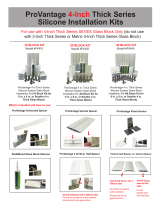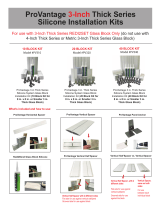
• This method is used to install straight walls in 4-sided
openings.
• In this method, glass block is installed in a perimeter
channel.
• The maximum opening size for exterior panels is 50
square feet, framed on all four sides.
• The maximum opening size for interior panels is 85
square feet, framed on at least two sides.
• The joints of these panels may be finished with grout
( see page 23 ), or silicone ( see page 24 )
1
• This method is used to install straight, curved, 45°,
and 90° angled attached walls at two, three or four
sides.
• In this method, glass block panels are secured to the
wall using special wall anchors.
• The maximum opening size for exterior panels is 50
square feet, framed on all four sides.
• The maximum opening size for interior panels is 85
square feet, framed on at least two sides.
• The joints of these panels may be finished with grout
( see page 23 ), or silicone ( see page 24 )
Installation Method
#
2 (Wall Anchor Construction)
Installation Method
#
1 (Channel Construction)
Glass Block Silicone Installation System
Assembly Instructions
Seves Glass Block
The installation systems described in this booklet make
achieving professional installation results of SEVES Glass
Block easy. They are compatible with the ProVantage
®
for
3-inch and 4-inch block sizes, the KWiK’N-EZ
®
for 80mm
blocks, and the myMINIGLASS
™
glass blocks.






















